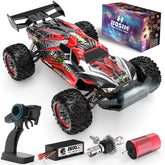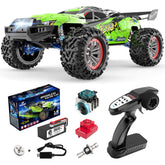How to Make Your RC Body Shell Last Longer
The exact definition of “bashing” varies depending on who you ask. To some, bashing is simply driving your favorite RC around, without abiding by any strict sets of rules or regulations (like you would in a race). Casual driving? That’s bashing! However, there’s also another type of bashing, and this is likely the type you’ve seen on YouTube. Taking your RC car to the skatepark, sending it off of a halfpipe, and seeing if it survives? That’s bashing!
No matter if your bashing style is casual or extreme, you’ll likely end up damaging your RC’s body at some point. True, you could simply buy another one, but if you’re constantly replacing bodies then this can become expensive. To help you save money and get the most out of your current RC body, we’ve gathered three different methods you can use to reinforce your RC’s Lexan body.
Prepping Your RC Body for Reinforcement
You’ll need to clean the surface on the underside of your RC body before you can reinforce it. Fortunately, this is a simple process: all you’ll need is some rubbing alcohol and paper towels! Dab a paper towel with some rubbing alcohol, then start to clean the body’s underside. Repeat this process until the entire underside of the Lexan body has been wiped. If there’s any dirt or grime on the paper towels, repeat the process until there isn’t. Once the body is sufficiently clean, leave it alone to completely dry while you gather the necessary supplies for your choice of reinforcement method.
The Reinforced Aluminum Foil Tape Method
Reinforcement Level: MinimalBest for: Minor Repairs/Light Reinforcement
Required Items:
Approximate Time Commitment: 30+ minutes
Suitable Project Location: Inside/Outside
Get the Hard-to-Reach Places First
Starting at the front of the body, begin to apply tape directly to the inside of the Lexan. It’s best to tape the corners of the vehicle first (since these are the hardest to reach). Use your fingers to flatten the tape, ensuring full surface contact. After the corners have been taped, apply additional tape to any grooves or other hard-to-reach places.
Tape the Rest of the Body
Next, you’ll be taping the large surface areas. The ideal taping pattern will vary depending on your body style, but you should aim to apply the longest strips possible. This will minimize the number of tape strips you’ll need to make! An easy way to proceed is by placing one strip from the front to the back of the body. From here, you can work your way out, overlapping the strips for complete coverage. Remember to flatten the tape as you go for complete contact!
Continue this process until the entire underside of the body has been taped. Don’t worry about taping over the body post holes (we’ll be cutting them out later on!). You might have to adjust your taping pattern once you begin to reach the edges. This is fine: just try to find the best way to apply the longest strips possible. For the bumpers, you may find that a side-to-side approach works better.
Trim the Excess Tape
After the entire underside has been sufficiently taped, grab your scissors and cut out the body post holes. Once that’s complete, you can trim around the edges of the body until the tape stops where the body ends. Finished? Your RC body is reinforced and ready to use!
| Pros | Cons |
| Works for repairs & reinforcements | Time-consuming |
| Flexible tape | Offers limited reinforcement |
| Affordable | Attracts debris if not trimmed cleanly |
Method #2: Gorilla Tape
Reinforcement Level: MediumBest for: Casual Bashing
Required Items:
Approximate Time Commitment: 30+ minutes
Suitable Project Location: Inside/Outside
Start With the Corners and Grooves
This method is identical to the one listed above, except that you’ll be using Gorilla Tape instead of reinforced aluminum tape! Gorilla Tape strips are fairly wide, which means that this process should be slightly quicker. Still, it does have some complications.
Just like before, begin by applying tape to the corners, ridges, and other hard-to-reach places. Gorilla Tape isn’t as flexible as aluminum tape, so you’ll need to take extra care to ensure full contact between the tape and the Lexan! Apply the tape, then press your finger over the tape to ensure complete contact. After those initial areas are completed, you can begin to apply longer strips.
Taping and Trimming
Apply one centered strip from the front to the back of the body. From here, you can work towards the sides of the body, overlapping the tape as you go. Remember, getting complete contact between the tape and the Lexan is critical, so don’t be afraid to switch up your taping patterns as needed. Once the entire underside has been taped, you can use the scissors to cut out the body post holes and trim the edges.
Pro Tip: After applying each strip, use a heat gun (on low) to warm the tape before pressing it down again. This will provide you with even better adhesion!
| Pros | Cons |
| Sufficient for most users | Time-consuming |
| Gorilla Glue is widely available | Not as effective as Shoe Goo/Drywall Tape |
| Affordable | Harder to reach corners and grooves |
The Shoe Goo & Drywall Tape Method
Reinforcement Level: HeavyBest for: Heavy Bashing
Required Items:
Approximate Time Commitment: 60+ minutes
Suitable Project Location: Outside/In a Well-Ventilated Area
Precautions
First things first: Shoe Goo is a toxic and flammable substance! As such, you’ll want to complete this process either outside or in a well-ventilated area. Once you’re in a suitable location, begin to heat your hot glue gun. After that’s ready to go, you can begin to apply the drywall tape!
Applying the Drywall Tape
Begin applying tape at the front of the vehicle. The drywall tape is self-adhesive so it will stick to the underside of the Lexan. However, this adhesive isn’t very strong so you’ll need to secure the tape using the hot glue gun. Unlike the previous methods, you should lay the tape strips next to each other, rather than overlapping them.
Using the Hot Glue
Make sure the tape has complete contact with the Lexan before applying the glue. You’ll want to be quick, using only as much glue as necessary. If you apply too much glue or hold the glue gun in a single place for too long, the heat might deform the Lexan! Small, quick dots and dabs of glue should be sufficient. Like with the previous two methods, corners and grooves will require a bit of extra attention. You can secure them with glue, but make sure not over-apply the glue.
You’re going to continue this tape-and-glue process across the entire underside of the body. It’s important that the drywall tape is completely flush with the Lexan and secured in place before moving on to the next step.
Applying the Shoe Goo
Now that the underside has been taped and glued, it’s time to whip out the Shoe Goo! Put on your gloves, squirt some Shoe Goo onto one of your fingers, and begin to smear the Goo into the tape. You’ll want to ensure all the little crevices in the tape are filled with Goo. Once you’ve made a pass, there should only be a thin layer of Goo spread across the tape. Try to avoid overapplying the Goo, as this will extend the drying process. Wait thirty minutes after your first layer has been completed, then check to see if it has dried.
Reinforcing the Reinforcements
After your first layer has dried, you can go back and apply additional layers of Shoe Goo. You can also add more drywall tape if you wish. We’d recommend applying a minimum of one layer of tape and two layers of glue. However, it’s important to remember that the more layers you add, the heavier your body will be. Once you’ve completed applying your layers of Shoe Goo and drywall tape, use the scissors to cut out the body post holes. Finally, trim around the edges, and voila: your RC is ready to bash!
| Pros | Cons |
| Results in a durable shell | Very time-consuming |
| Bends with impacts | Requires more materials |
| Cheap | Shoe Goo is toxic and flammable |
By Kevin Foley





















































































































Leave a comment
Please note, comments need to be approved before they are published.